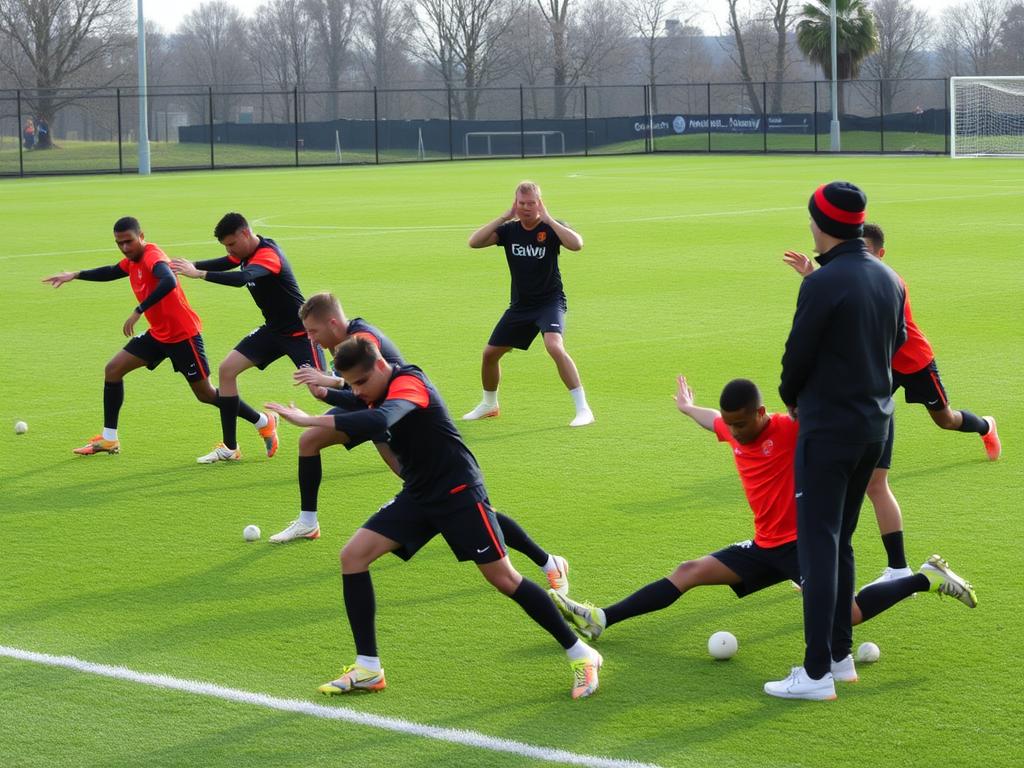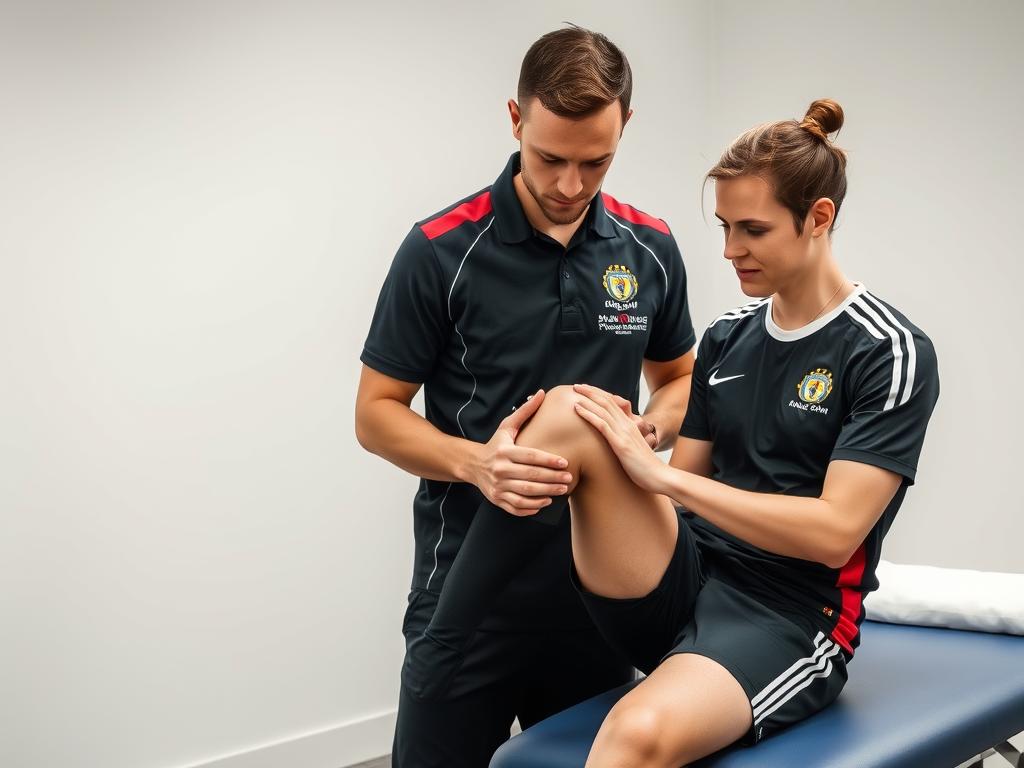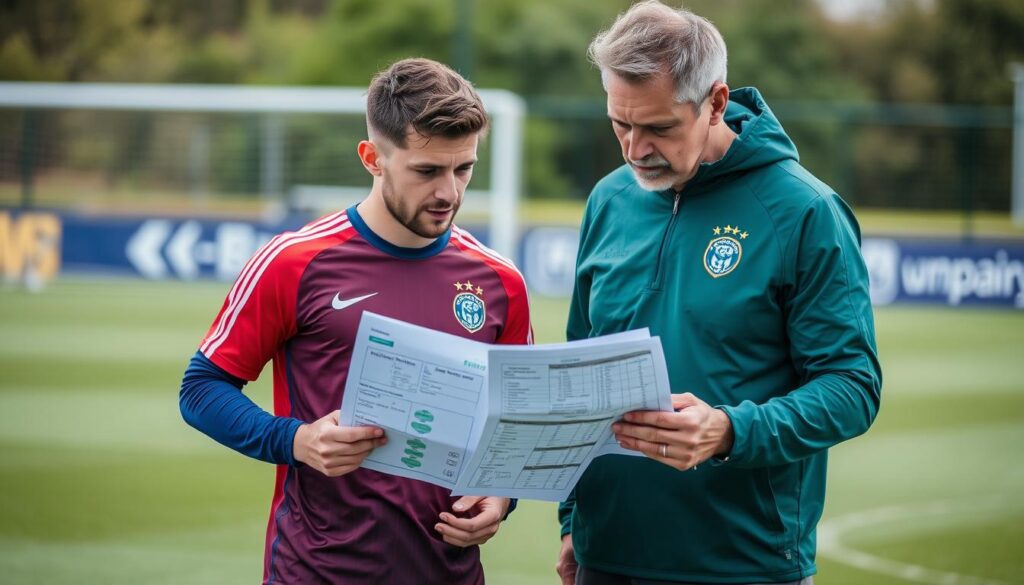Soccer demands quick pivots, sudden stops, and explosive directional changes that put tremendous stress on your knees. With knee injuries sidelining players at all levels, understanding how to protect these crucial joints isn’t just about staying in the game—it’s about preserving your long-term health and athletic career. This comprehensive guide provides actionable strategies to help you minimize risk and maximize performance on the pitch.
Common Knee Injuries in Soccer Players
Understanding what you’re up against is the first step in prevention. Soccer players commonly face these knee injuries:
Anterior Cruciate Ligament (ACL) Tears
ACL tears are among the most devastating knee injuries in soccer. They typically occur during non-contact situations like sudden deceleration, landing awkwardly, or changing direction rapidly. Recovery often requires surgery and 6-9 months of rehabilitation.
Meniscus Tears
The meniscus is cartilage that cushions your knee joint. These tears commonly happen when players twist their knee while the foot is planted, often during quick turns or tackles. About 25-30% of soccer knee injuries involve meniscus damage.
Collateral Ligament Sprains
These account for approximately one-third of all knee injuries in soccer. The medial collateral ligament (MCL) and lateral collateral ligament (LCL) can be damaged during tackles or when the knee is forced sideways.
Patellofemoral Pain Syndrome
Often called “runner’s knee,” this condition causes pain around the kneecap and is common in sports requiring running and jumping. It develops gradually from overuse rather than from a single incident.
Why Soccer Players Are Vulnerable to Knee Injuries

Soccer places unique demands on your knees that increase injury risk:
- Rapid pivoting and directional changes that stress ligaments
- Sudden deceleration that creates shearing forces in the knee
- Improper landing technique after jumps or headers
- Player-to-player contact during tackles and challenges
- Overtraining without adequate recovery time
- Playing on uneven or hard surfaces
- Muscle imbalances between quadriceps and hamstrings
Dr. James Andrews, renowned sports medicine surgeon, notes: “The majority of soccer knee injuries occur not from contact but from the player’s own movement patterns and biomechanical issues that can be addressed through proper training.”
Step-by-Step Prevention Strategies
1. Strengthen Key Muscle Groups

Building strength in the muscles that support your knees is crucial for injury prevention. Focus on these exercises:
Quadriceps Strengthening
- Bulgarian Split Squats: Place one foot on a bench behind you, bend your front leg until your thigh is parallel to the ground, then push back up. Do 3 sets of 10-12 reps per leg.
- Forward Lunges: Step forward into a lunge position, ensuring your knee doesn’t extend past your toes. Return to starting position and alternate legs. Complete 3 sets of 12 reps.
- Wall Sits: With your back against a wall, slide down until your thighs are parallel to the floor. Hold for 30-60 seconds, rest, and repeat 3 times.
Hamstring Development
- Nordic Hamstring Curls: Kneel with someone holding your ankles. Lower your upper body toward the ground as slowly as possible, using your hamstrings to control the descent. Do 3 sets of 5-8 reps.
- Stability Ball Leg Curls: Lie on your back with heels on a stability ball. Lift your hips and pull the ball toward you by bending your knees. Do 3 sets of 12-15 reps.
Hip Abductor Training
Weak hip abductors can cause the thigh to rotate inward during running, placing stress on the knee joint. Try these exercises:
- Lateral Band Walks: Place a resistance band around your ankles. In a half-squat position, step sideways while maintaining tension in the band. Do 3 sets of 12-15 steps in each direction.
- Clamshells: Lie on your side with knees bent and a resistance band around your thighs. Keep feet together while opening your knees like a clamshell. Complete 3 sets of 15-20 reps on each side.
2. Develop Proper Movement Patterns

How you move is just as important as how strong you are. Train your body to move safely with these techniques:
Proprioceptive Training
Proprioception is your body’s awareness of position and movement. Improving it helps prevent awkward movements that lead to injuries.
- Single-Leg Balance: Stand on one leg for 30 seconds. Progress by closing your eyes or standing on an unstable surface like a foam pad. Do 3 sets on each leg.
- Balance Board Exercises: Use a balance board to perform squats or passes with a soccer ball. Start with 30-second intervals and gradually increase duration.
Landing Mechanics
Many ACL tears occur during landing. Practice these techniques:
- Squat Jumps with Proper Landing: Jump vertically, focus on landing softly with knees bent and aligned with your toes. Do 3 sets of 10 jumps.
- Single-Leg Landings: Jump and land on one foot, focusing on knee stability and alignment. Perform 3 sets of 8 reps per leg.
Deceleration Training
Learning to slow down properly reduces knee strain:
- Three-Step Stops: Instead of stopping abruptly, practice decelerating over three steps with bent knees. Perform 10 repetitions at increasing speeds.
- Change-of-Direction Drills: Set up cones in a zigzag pattern. Practice cutting with proper technique: plant outside foot, bend knees, and pivot without letting knees collapse inward.
3. Implement Effective Warm-Up and Cool-Down Routines

A proper warm-up prepares your body for the demands of soccer while reducing injury risk:
Dynamic Warm-Up (10-15 minutes)
- Light jogging or skipping for 3-5 minutes to increase blood flow
- Dynamic stretches: leg swings, walking lunges, high knees, butt kicks (8-10 reps each)
- Sport-specific movements: side shuffles, carioca, acceleration/deceleration drills
- Jumping exercises: small hops progressing to more explosive movements
According to FIFA’s 11+ injury prevention program, teams that regularly perform structured warm-ups experience 30-50% fewer injuries.
Post-Game Cool-Down (5-10 minutes)
- Light jogging or walking to gradually reduce heart rate
- Static stretching for major muscle groups (hold each stretch 20-30 seconds)
- Focus on quadriceps, hamstrings, calves, and hip flexors
- Self-myofascial release with foam rollers for tight areas
4. Choose Proper Equipment and Playing Surfaces

Your gear and playing environment significantly impact knee safety:
Footwear Selection
- Choose cleats appropriate for your playing surface (firm ground, soft ground, artificial turf)
- Ensure proper fit with adequate toe room and heel support
- Replace worn cleats that no longer provide proper traction
- Consider custom insoles if you have flat feet or high arches
Protective Equipment
- Knee braces can provide additional support for players with previous injuries
- Compression sleeves improve proprioception and provide mild support
- Proper shin guards that cover the lower leg adequately
Surface Considerations
Be mindful of playing surfaces and adjust accordingly:
- Hard or uneven surfaces increase injury risk—modify play intensity when necessary
- Artificial turf may increase friction and resistance during cuts and turns
- Wet or muddy fields require adjusted footwear and more cautious movement
Nutrition and Recovery for Knee Health

What you put in your body and how you recover impacts knee resilience:
Hydration and Diet
- Stay well-hydrated—dehydrated muscles don’t function optimally
- Consume anti-inflammatory foods like fatty fish, berries, and leafy greens
- Ensure adequate protein intake for muscle repair (1.2-1.7g per kg of body weight)
- Consider collagen supplements, which may support ligament and tendon health
- Maintain adequate vitamin D and calcium levels for bone health
Recovery Protocols
- Follow the R.I.C.E. protocol (Rest, Ice, Compression, Elevation) for minor knee discomfort
- Schedule adequate rest days between intense training sessions
- Consider contrast therapy (alternating hot and cold) for recovery
- Get 7-9 hours of quality sleep for optimal tissue repair
- Gradually return to play after any injury, even minor ones
Early Warning Signs and Injury Management

Knowing when to seek help can prevent minor issues from becoming serious injuries:
Warning Signs That Shouldn’t Be Ignored
- Persistent pain that lasts more than 48 hours after playing
- Swelling around the knee joint
- Clicking, popping, or grinding sensations
- Instability or feeling that the knee might “give way”
- Limited range of motion or difficulty bearing weight
When to Seek Professional Help
Don’t hesitate to consult a healthcare provider if you experience:
- Inability to complete a full training session due to knee discomfort
- Pain that interferes with daily activities
- Visible deformity or severe swelling
- Symptoms that don’t improve with rest and basic care
Physical therapist Sarah Johnson emphasizes: “Early intervention for knee issues can mean the difference between a quick return to play and a season-ending injury. Don’t try to push through significant pain.”
Developing a Long-Term Prevention Plan

Injury prevention isn’t a one-time effort but a consistent approach:
Periodization and Training Load
- Gradually increase training intensity and volume (no more than 10% per week)
- Schedule deload weeks to allow for recovery
- Balance high-intensity sessions with adequate recovery
- Monitor for signs of overtraining like persistent fatigue or decreased performance
Seasonal Considerations
- Pre-season: Focus on building strength and proper movement patterns
- In-season: Maintain strength with less volume but consistent frequency
- Off-season: Address imbalances and work on areas of weakness
- Transition periods: Gradually ramp up intensity when returning after breaks
Regular Assessments
Consider scheduling:
- Pre-season movement screenings to identify risk factors
- Mid-season check-ins to address emerging issues
- Post-season evaluations to guide off-season training
Your Commitment to Knee Health

Preventing knee injuries in soccer requires consistent effort and awareness, but the rewards are substantial: longer playing careers, better performance, and fewer painful setbacks. By implementing the strategies in this guide, you’re taking control of your athletic future.
Remember that small, consistent actions make the biggest difference. Start with one or two exercises from each section and gradually build your prevention routine. Your knees will thank you for years to come.
As professional goalkeeper Hope Solo once said: “Taking care of your body isn’t just about being able to perform at your best today—it’s about being able to play the sport you love for as long as possible.”
Protect Your Soccer Career
Download our free 15-minute pre-game knee protection warm-up routine designed by professional sports physiotherapists.
Need Personalized Guidance?
Book a free 15-minute consultation with a sports physical therapist specializing in soccer injuries. Get customized prevention strategies for your specific needs.
Protect Your Soccer Future
Download our complete knee injury prevention package including warm-up routines, strength training programs, and recovery protocols designed specifically for soccer players.

Leave a Reply